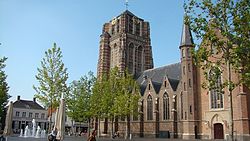|
Oosterhout
 Oosterhout (Dutch pronunciation: [ˈoːstərɦʌut] ⓘ; from ooster, "eastern", and hout, "woods") is a municipality and a city in southern Netherlands. The municipality had a population of 56,206 in 2021. Population centersThe municipality of Oosterhout includes the following places: HistoryOosterhout is mentioned for the first time in 1277, although archaeological excavations showed the existence of human settlements in the area in prehistoric times. The Knights Templar had a temple here dedicated to St. John the Baptist. It was home to a castle which later acquired control over the surrounding area, up to Breda and Bergen op Zoom. The castle was destroyed by Spanish troops during the Eighty Years War, in 1573; only a tower of it survives today. The city became the seat of a flourishing ceramics industry, which lasted until the 19th century. In 1625 the city was besieged by Frederick Henry, Prince of Orange, and suffered heavy damage. Despite the rise of Protestantism, it was home to several Catholic monasteries, including that of the Premonstratensians, which is still active. Oosterhout received city rights in 1809, by will of Louis Bonaparte. Main sights
CultureDe anoniemen, a group of statues created by Paul Elshout, is situated in Slotpark. SportOosterhout is home to several sports clubs, for example volleyball club VOKO, football clubs SCO-Tofs, VV Oosterhout, baseball club Twins and hockey club De Warande. Sport clubs
Notable people
Sport
Gallery
References
External links
|
||||||||||||||||||||||||||||||||||||||||||||||||||







